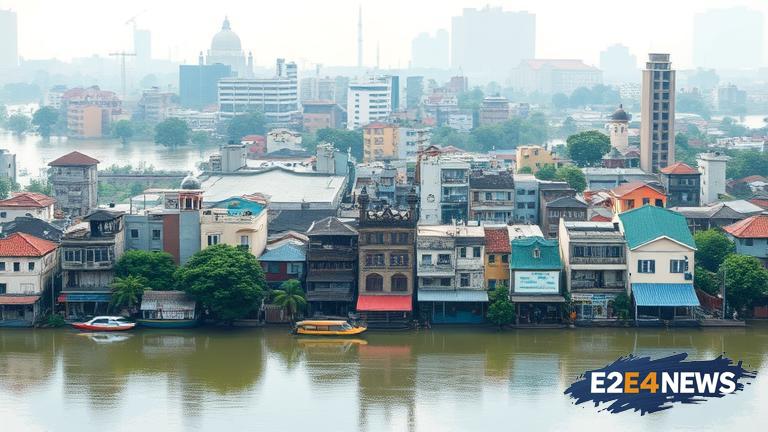India is a country prone to natural disasters, with flooding being one of the most common and devastating ones. The country’s urban areas are particularly vulnerable to flooding, with many cities facing the threat of flooding due to heavy rainfall, poor drainage, and climate change. According to recent reports, several cities in India are at high risk of flooding, with some of the most flood-prone cities including Mumbai, Kolkata, Chennai, and Bangalore. These cities are not only densely populated but also have a high economic value, making them a priority for urban planning and flood mitigation efforts. Mumbai, for example, is known for its heavy rainfall during the monsoon season, which often causes flooding in the city’s low-lying areas. The city’s poor drainage system and rapid urbanization have exacerbated the problem, making it one of the most flood-prone cities in the country. Kolkata, on the other hand, is prone to flooding due to its location in the Ganges-Brahmaputra delta, which makes it vulnerable to storm surges and heavy rainfall. Chennai, which was severely affected by the 2015 floods, is also at high risk of flooding due to its low-lying coastal areas and poor drainage system. Bangalore, known for its rapid urbanization and poor planning, is also facing the threat of flooding due to its haphazard development and lack of effective drainage systems. Other cities, such as Hyderabad, Ahmedabad, and Pune, are also at risk of flooding due to their rapid growth and poor urban planning. The Indian government has launched several initiatives to mitigate the effects of flooding, including the National Disaster Management Plan and the Smart Cities Mission. However, more needs to be done to address the root causes of flooding, including poor urban planning, lack of effective drainage systems, and climate change. The government needs to work with local authorities, urban planners, and residents to develop sustainable and resilient urban planning strategies that take into account the risks of flooding. This includes investing in flood-resistant infrastructure, improving drainage systems, and promoting green spaces and wetlands that can help absorb excess water. Additionally, there is a need for greater awareness and education about flood risk and mitigation, particularly among residents and businesses in flood-prone areas. By working together, India can reduce the risks associated with flooding and create more resilient and sustainable cities for its growing urban population. The country’s flood-prone cities are not just a challenge but also an opportunity for innovation and growth, with many cities exploring new technologies and strategies for flood mitigation and management. For example, some cities are using advanced mapping and modeling techniques to predict and prepare for floods, while others are investing in green infrastructure and nature-based solutions to reduce flood risk. Overall, India’s flood-prone cities require a comprehensive and multi-faceted approach to address the complex challenges of flooding, and it is only through a collaborative effort that the country can create more resilient and sustainable urban areas. The impact of flooding on India’s economy and human settlements cannot be overstated, with flooding causing significant damage to infrastructure, property, and human life. Therefore, it is essential that the government, local authorities, and residents work together to develop effective strategies for flood mitigation and management. By doing so, India can reduce the risks associated with flooding and create a more sustainable and resilient future for its urban population. Furthermore, the country’s flood-prone cities are also vulnerable to other natural disasters, such as cyclones and heatwaves, which can exacerbate the effects of flooding. Therefore, it is essential to develop a comprehensive disaster management plan that takes into account the multiple risks and challenges faced by India’s urban areas. In conclusion, India’s flood-prone cities are a growing concern for urban planning, and it is only through a collaborative effort that the country can create more resilient and sustainable cities. The government, local authorities, and residents must work together to develop effective strategies for flood mitigation and management, and to promote sustainable and resilient urban planning practices that prioritize the needs of residents and the environment.
